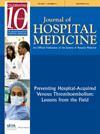Evaluating the impact of patient–staff interactions on sleep opportunities using the electronic health record
Abstract
Background
Hospitalized patients often experience disrupted sleep due to nighttime patient–staff interactions (PSIs). This study evaluates how PSIs impact sleep opportunities in neurology inpatients using electronic health record (EHR) data and introduces surrogate measures of sleep such as longest uninterrupted sleep opportunity (LUSO) and interruptive episodes.
Objective
To develop a methodology leveraging time-stamped EHR data to quantify and visualize the impact of PSIs on inpatient sleep opportunities.
Methods
We analyzed 3305 patient nights in an inpatient neurology unit, categorizing PSIs into six types: vital signs, neurological checks, medication administration, bedside diagnostic testing, off-unit diagnostic testing, and bed changes. We calculated LUSO and interruptive episodes and used a linear mixed model to assess the relationship between PSIs and LUSO.
Results
PSIs occurred in 92% of patient nights, averaging 2.81 interruptive episodes and 4.06 h of LUSO per night. Vital signs and medication administrations were the most frequent PSIs. Neurological checks and off-unit diagnostic testing were associated with the largest reductions in LUSO (approximately 40 min), followed by bed changes (−33.79 min).
Conclusion
This study demonstrates the utility of LUSO and interruptive episodes as EHR-based measures to link PSIs to sleep opportunities. While vital signs and medications were the most frequent PSIs, neurological checks and off-unit testing were associated with the largest impact on reducing LUSO. The predominance of single-PSI interruptive episodes underscores that the bundling of PSIs is not occurring. These findings highlight that PSIs impact sleep opportunities in distinct ways, supporting the use of this methodology to evaluate and address EHR-linked disruptions to patient sleep.

 求助内容:
求助内容: 应助结果提醒方式:
应助结果提醒方式:


